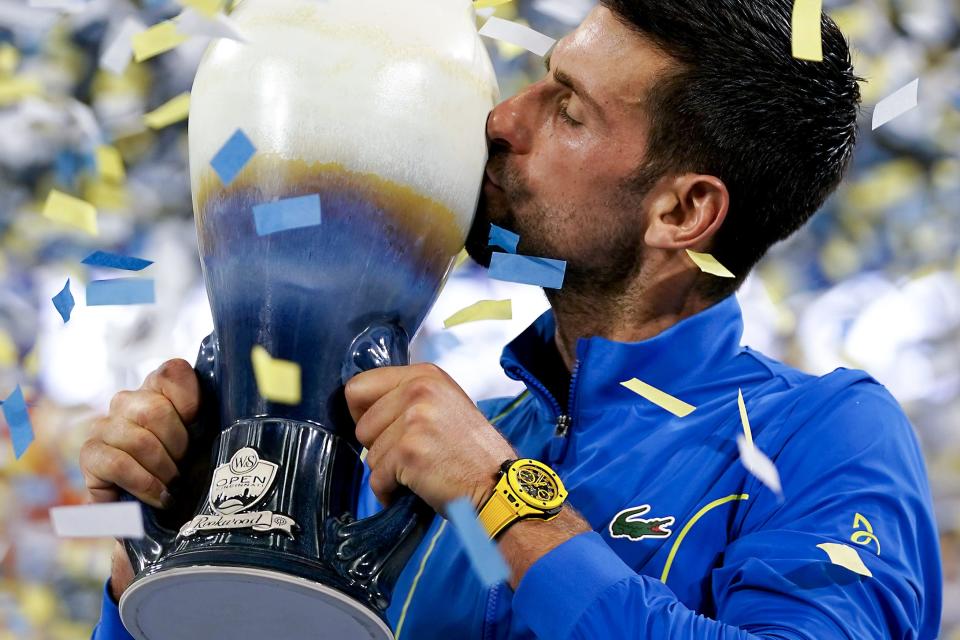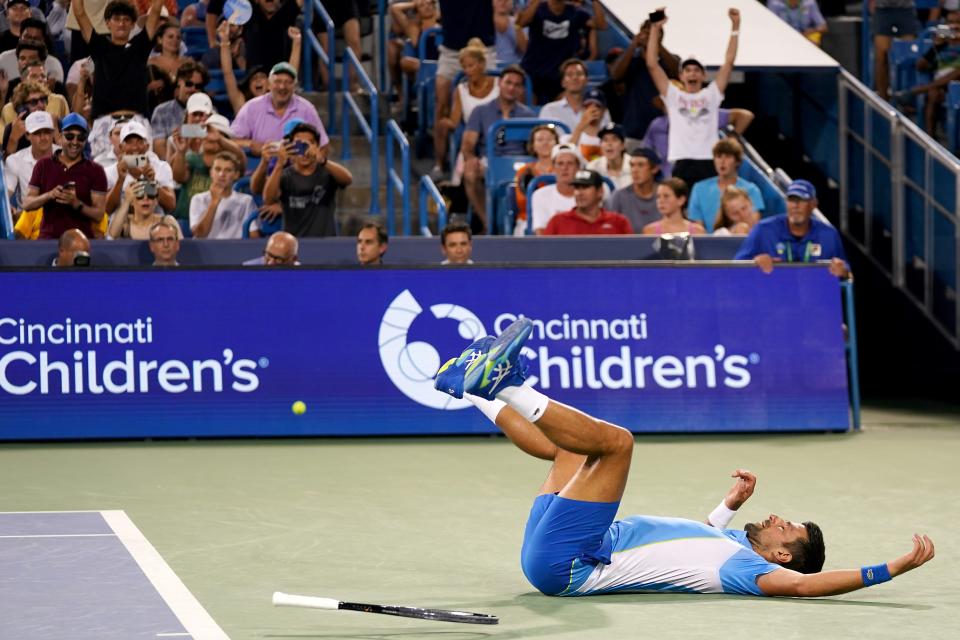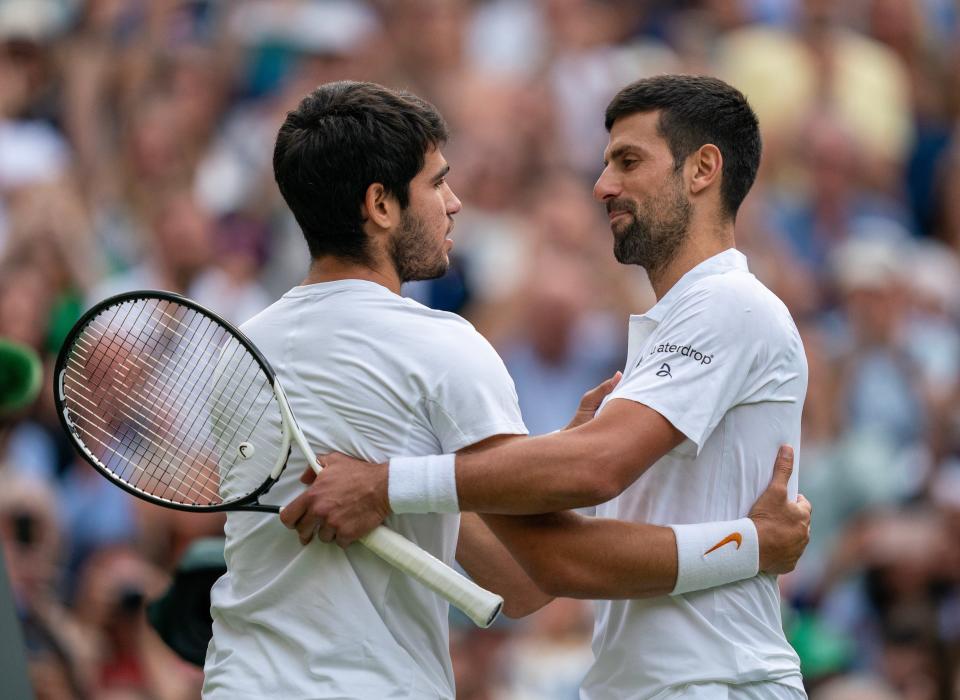Novak Djokovic's results at US Open have been different from other Grand Slams: Here's why
NEW YORK — After missing last year’s U.S. Open because of government regulations prohibiting foreigners from entering the country without a COVID-19 vaccination, Novak Djokovic returns on Monday night in a first-round match against France’s Alexandre Muller.
Despite a cold reception in New York over the years, Djokovic’s last match in Arthur Ashe Stadium was one of the most emotional of his career as fans tried unsuccessfully to lift him to the calendar Grand Slam in 2021.
"I didn’t perform well that day in terms of tennis," Djokovic said Friday, reflecting on his straight sets finals loss to Daniil Medvedev. "But what I felt from the crowd, that kind of connection and love and support that they gave me throughout entire match and also in the closing ceremony, was something that I carry still in my heart, and I still feel vibes from that night."
Though Djokovic’s relationship with New York fans might have turned in a more adoring direction, the U.S. Open has strangely been the most difficult Grand Slam title for him to win.
2023 US OPEN: Time, TV, streaming info for year's fourth and final Grand Slam
OPINION:After second tournament title this summer, Coco Gauff could be the US Open favorite

Djokovic has almost always performed well in Flushing, but for some reason − whether letdowns, injuries or just some flat-out weird developments − it’s been a struggle to get over the finish line.
Djokovic, in fact, "only" has three U.S. Opens among his record 23 Grand Slam titles, with the most recent coming in 2018. Though three is nothing to sneeze at, it’s a strange dichotomy with the Australian Open, which he has won 10 times on a similar hard court surface. Djokovic also has won Wimbledon seven times and the French Open three times, the latter being more easily explained by Rafael Nadal’s historic dominance on clay.
"I would have expected him to have won more based on (that)," said John McEnroe, the four-time U.S. Open champ who has commentated hundreds of Djokovic matches on ESPN. "I mean, three ain’t bad. And he’s been in a lot of finals, so not going to lose sleep over that."
Fair enough. But it’s at least interesting that Djokovic, arguably the greatest player ever, has had a tortured history here relative to other venues.
Here’s a look back at some of his missed opportunities and perhaps an explanation for why his results at the U.S. Open have been different from the other majors.
US Open's place on tennis calendar leads to randomness
The most straightforward theory is that the U.S. Open takes place at the end of eight months of nonstop, globetrotting tennis, which means many players show up in New York fatigued or trying to manage nagging injuries.
At the Australian Open in January, everyone is healthy and fresh and generally in peak form. But the tennis season is a grind that requires players to make several surface changes and adapt to different conditions. Plus, once the French Open starts in late May, the next three Grand Slams come in pretty quick succession, which can be a real mental and physical test.
That’s probably why, in general, the U.S. Open has had more diversity among the winners during the Big Three era. Though Roger Federer (five) and Nadal (four) won their share of U.S. Opens, it’s also a tournament where Juan Martin del Potro, Marin Cilic, Dominic Thiem and Medvedev hoisted their only major trophy.
"It could be the fact that it's in the end of the season in a way," Djokovic said. "It's been eight tough months for all the players. Maybe that's the reason why you would probably see more surprises in this Grand Slam than maybe some other Slams. That's the only thing that really comes to my mind."
Fatigue certainly seemed to play a big role for Djokovic in 2021 when he lost to Medvedev. After winning the first three Slams and also playing the Olympics in Tokyo, he seemed to be running on fumes a bit in New York and was unable to conserve energy after dropping the first set in four straight matches leading up to the final.
Novak Djokovic’s difficulties in US Open finals
Djokovic’s 3-6 record in U.S. Open finals stands in significant contrast to Wimbledon (7-2), Roland Garros (3-4) and Australia (10-0). But digging further into those matches, there’s not much of a common thread.
In 2007, a 20-year old Djokovic was simply in over his head playing his first Grand Slam final against prime Federer. In 2010 and 2013, Djokovic simply got beat by Nadal, who had complete command of both matches. In 2016, Djokovic suffered a decisive loss to Stan Wawrinka, who had beaten him in the French Open final the year before and had been a problematic matchup for him throughout their careers. And we’ve already covered 2021, when Medvedev played what he called "definitely one of, if not the best, match of my life."
There’s only one finals loss Djokovic might have some regrets about.
As the defending champion in 2012, Djokovic climbed all the way back from losing the first two sets to Andy Murray and seemed to have all the momentum heading into the fifth against a player who hadn’t yet won a major. But Murray commanded the fifth set, and Djokovic physically faltered at the end of a final that lasted nearly five hours.

Novak Djokovic's strange circumstances in US Open
The one that really got away from Djokovic was 2020 coming out of the pandemic when the U.S. Open took place without any fans in attendance. After rolling through his first three matches, Djokovic looked like a massive favorite − particularly with no Federer or Nadal in the draw and nobody else on the men’s side with experience winning Grand Slams.
But in the fourth round against Pablo Carreño Busta, Djokovic smacked a ball in frustration after falling behind 6-5 in the first set. It ended up hitting a lineswoman in the neck, which resulted in an automatic disqualification from the tournament based on the rules. That opened the door for Thiem to win his U.S. Open, though it certainly felt as if the tournament was Djokovic’s to lose before the incident.
Djokovic also suffered a disappointing fourth-round exit one year earlier. Though he was the No. 1 seed in 2019, there were injury concerns coming into the tournament that began to manifest severely in the second round.
Though Djokovic was able to get through his first three matches, his shoulder gave out in the fourth round and he retired down two sets to Wawrinka.
There’s one other year where Djokovic had a real opportunity to win the title and let it slip. That was 2014 when he and Federer seemed to be on a collision course for the finals. Instead, an oddly flat Djokovic lost his semifinal pretty decisively to Ken Nishikori, whom he has beaten in 18 of 20 career meetings. Djokovic would have been a big favorite in the final against Cilic, who knocked out Federer and won the title.
Novak Djokovic facing Carlos Alcaraz obstacle in Grand Slams
It’s less clear how Djokovic would have fared last year had he been allowed to play, given that it was the coming out party for Carlos Alcaraz as a Slam champion. But he certainly would have entered the tournament with the best odds to win, and it would have been interesting to see how Alcaraz might have dealt with him at that stage of his development.

But after seeing them play two epic finals recently with Alcaraz winning Wimbledon and Djokovic turning the tables last week in Cincinnati, we could get a final answer on whether the 36-year old Djokovic can add one more U.S. Open to his résumé.
"Grand Slams are the biggest goals that I have in my career at the moment," he said. "I don’t know how many more Slams I’ll have. I’ll still keep going. I don’t have an end in my mind at the moment. I also understand that things are different when you're 36, so I have to be more appreciative, a bit more I guess present, treating every Grand Slam as maybe your last one in terms of commitment and performance. I see every Grand Slam that I play right now as really a golden opportunity to make more history."
This article originally appeared on USA TODAY: US Open: Why Novak Djokovic has missed some chances in this Grand Slam

